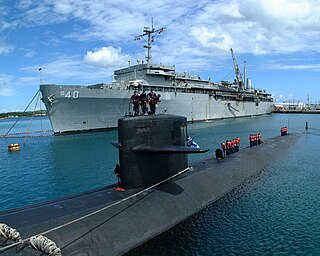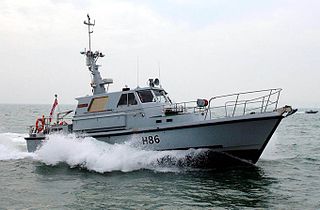
A submarine tender is a type of depot ship that supplies and supports submarines.

RFA Fort Austin is a retired British Fort Rosalie-class dry stores ship of the Royal Fleet Auxiliary.

Landing platform helicopter (LPH) is a term used by some navies to denote a type of amphibious warfare ship designed primarily to operate as a launch and recovery platform for helicopters and other VTOL aircraft. As such, they are considered a type of helicopter carrier.

The River class is a class of offshore patrol vessels built primarily for the Royal Navy of the United Kingdom. A total of nine were built for the Royal Navy (RN), four Batch 1 and five Batch 2. One Batch 1 (HMS Clyde), which was the Falklands guard ship, was decommissioned and transferred at the end of its lease to the Royal Bahrain Naval Force.

HMS Mersey is a River-class offshore patrol vessel of the British Royal Navy. Named after the River Mersey, she is the fifth RN vessel to carry the name and the first to be named Mersey in 84 years. Various tenders were renamed Mersey during their service with Mersey Division Royal Naval Reserve between the early 1950s and late 1970s.

HMSML Gleaner (H86) was the smallest commissioned vessel in the Royal Navy, at the time of her decommissioning, with a length of just under 15 metres and a ship's company of just nine. She was based in Devonport, Plymouth. The ship prefix "HMSML" stands for Her Majesty's Survey Motor Launch.

HMS Clyde was an offshore patrol vessel and was the tenth Royal Navy vessel to carry the name. She was launched on 14 June 2006 in Portsmouth Naval Base by VT Group shipbuilders in Portsmouth, England, and is the fourth vessel of the River class, with a displacement of 2,000 tonnes and a 30 mm Oerlikon KCB gun in place of the 20 mm gun fitted to Tyne River-class ships. Clyde was decommissioned on the 20 December 2019 at HMNB Portsmouth and was returned to her owners at BAE Systems Maritime - Naval Ships, although the ship remained under lease from BAE Systems to the Royal Navy until the end of March 2020. In August 2020 Clyde was transferred to the Kingdom of Bahrain.

HMS Tyne is a River-class offshore patrol vessel built by Vosper Thornycroft in Southampton for the Royal Navy to serve as a fishery protection unit within the United Kingdom's waters along with her two sister ships Mersey and Severn. All three were commissioned into service in 2003 to replace the five older Island-class patrol vessels.

HMS Caroline is a decommissioned C-class light cruiser of the Royal Navy that saw combat service in the First World War and served as an administrative centre in the Second World War. Caroline was launched and commissioned in 1914. At the time of her decommissioning in 2011 she was the second-oldest ship in Royal Navy service, after HMS Victory. She served as a static headquarters and training ship for the Royal Naval Reserve, based in Alexandra Dock, Belfast, Northern Ireland, for the later stages of her career. She was converted into a museum ship. From October 2016 she underwent inspection and repairs to her hull at Harland and Wolff and opened to the public on 1 July 2017 at Alexandra Dock in the Titanic Quarter in Belfast.

The Belgian Navy, officially the Belgian Naval Component of the Belgian Armed Forces, is the naval service of Belgium.

HMS Severn is a River-class offshore patrol vessel of the Royal Navy. Named after the River Severn, the ship is the first to bear the name in 56 years. She was built by Vosper Thornycroft in Southampton to serve primarily as a fishery protection unit within the United Kingdom's waters along with her two sister ships Mersey and Tyne. All three were commissioned into service in 2003 to replace the five older Island-class patrol vessels. The ship was decommissioned in 2017, but the Government decided to recommission her as part of Brexit preparedness. She returned to service in 2020 and was recommissioned into the Royal Navy on 28 August 2021.

HMS Severn (N57) was an ocean-going submarine of the River class. She was built by Vickers Armstrong, at Barrow, and launched on 16 January 1934. She was completed on 12 January 1935.

Aircraft carriers have their origins during the days of World War I. The earliest experiments consisted of fitting temporary "flying off" platforms to the gun turrets of the warships of several nations, notably the United States and the United Kingdom. The first ship to be modified with a permanent flight deck was the battlecruiser HMS Furious, which initially had a single flying-off deck forward of the original superstructure. Subsequently, she was modified with a separate "landing on" deck aft and later with a full flush deck. Other ships, often liners, were modified to have full flush flight decks, HMS Argus being the first to have such modification begun. Those first faltering steps gave little indication of just how important the aircraft carrier was to prove to be. During the inter-war years, Japan, the United Kingdom and the United States built up significant carrier fleets so that by the beginning of World War II, they had 18 carriers between them. The 1940 Battle of Taranto and 1941 Attack on Pearl Harbor in retrospect showed the world that the aircraft carrier was to be the most important ship in the modern fleet. Today, aircraft carriers are the capital ships of the navies they serve in, and in the case of modern US "supercarriers", they embark an air group that is effectively a small air force.

By taking on ships being built for foreign navies in British shipyards, a number of British-built 6-inch 50-calibre naval guns found their way into British service in World War I. Their specifications and performance differed from standard Royal Navy 6-inch guns but in British service they fired standard service 100-pound projectiles.













